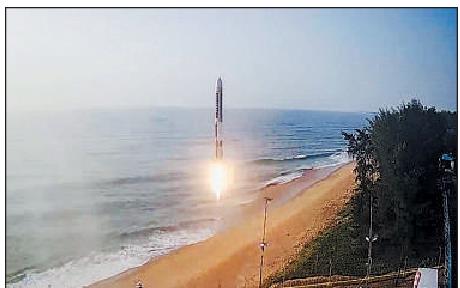Tested: A rocket set up in 3 days
WORLD S FIRST 3D-PRINTED ENGINE: PRIVATE FIRM
G. S. MUDUR New Delhi: An India-based aerospace company said on Thursday that it had launched the world s first rocket powered by a so-called "single piece 3D printed engine" that promises unparalleled cost and speed advantages in the commercial satellite market
The rocket, developed by Agnikul Cosmos, took off at 7.15am on Thursday from the Sriharikota island spaceport off the Andhra Pradesh coast for a flight that lasted only 65 seconds but demonstrated key technologies that distinguish it from all earlier Indian rockets
The rocket reached a height of 5.6km before plunging into the Bay of Bengal following a parabolic flight
The test flight was The Agnibaan rocket being launched from Sriharikota on Thursday. (PTI picture) designed to demonstrate homegrown technologies, gather flight data and ensure the proper functioning of launch-related systems, Agnikul said in a statement
The rocket, named Agnibaan, can be tailored to ferry 30kg to 300kg payload into low Earth orbit. It is India s first rocket powered by a semi-cryogenic engine that runs on a kerosene-like fuel and liquid oxygen. A semi-cryogenic engine is easier to handle than a full cryogenic engine, which uses liquid hydrogen and liquid oxygen
Agnikul has described the engine as the first in the world to be fabricated through 3D printing, an industrial process that uses computer-aided design and 3D object scanners to create objects with precise geometric shapes, layer upon layer
"With 3D printing, we can build the engine with its 1,000-plus parts in just three days," said Satyanarayanan R. Chakravarthy, professor of aerospace engineering at the Indian Institute of Technology, Madras, and a founding adviser to Agnikul
"With conventional precision machining, it would take about a month to build such an engine." The combination of 3D printing and semi-cryogenicity is expected to reduce the launch cost for customers by twofold to threefold from current commercial launch costs, depending on the payloads, Chakravarthy said.
